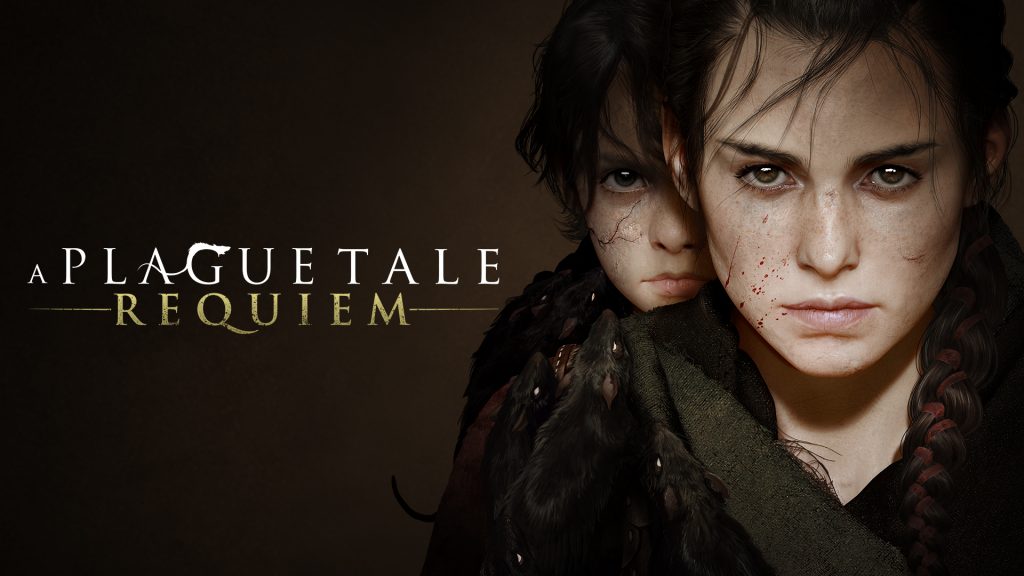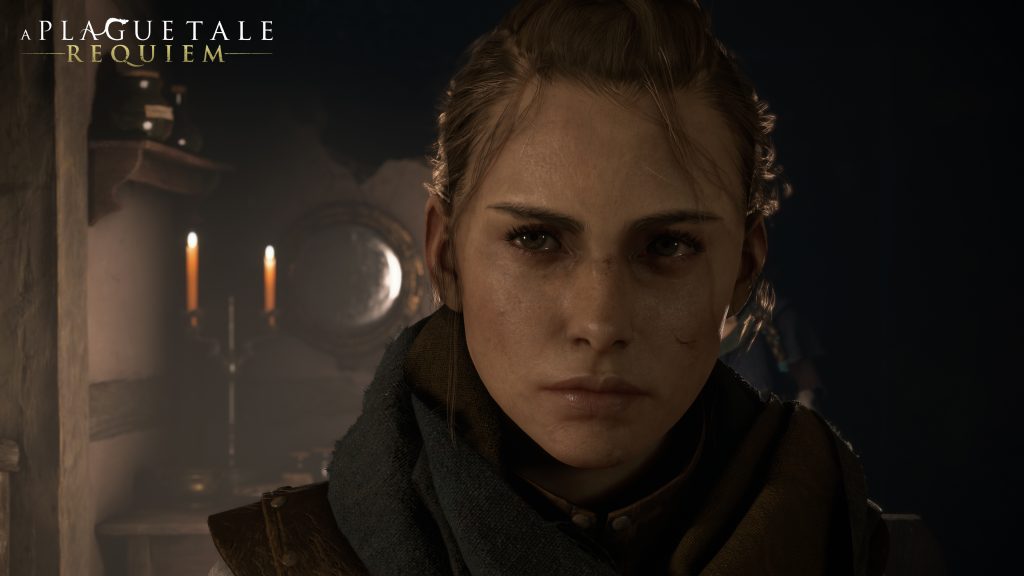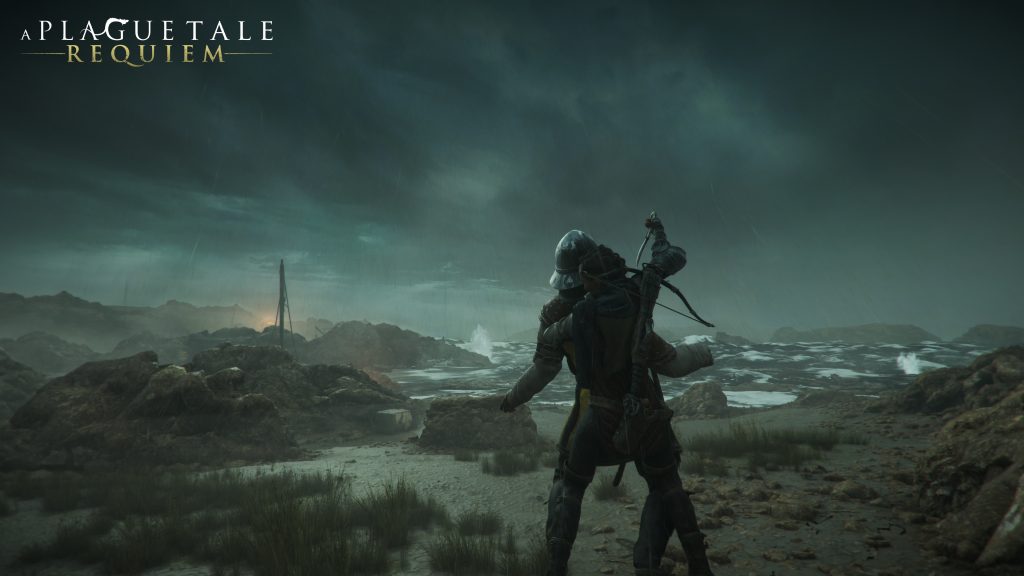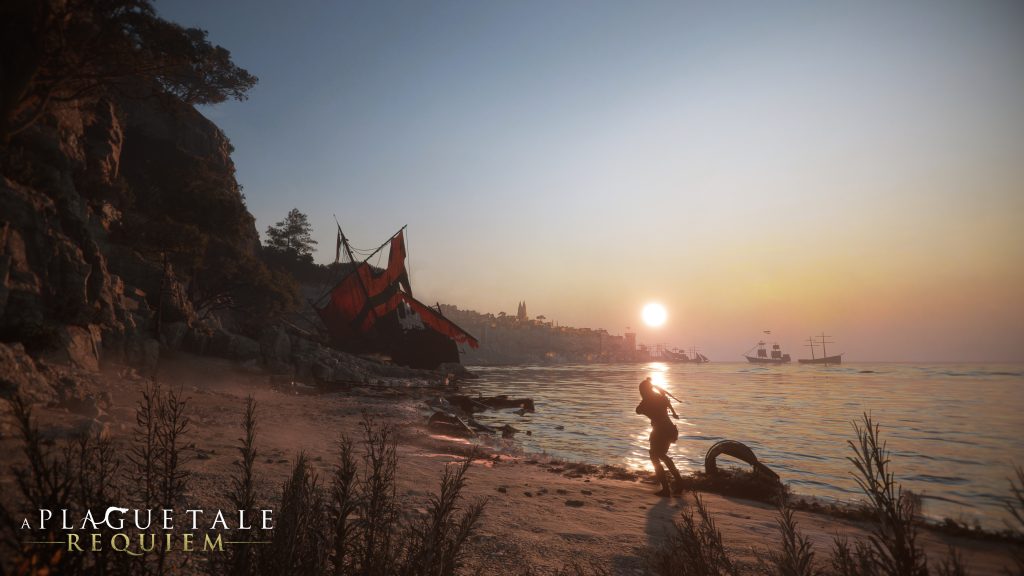A Plague Tale: Requiem is the follow-up to 2019’s Innocence, a game that seemed to come out of nowhere to astound with its clever stealth gameplay and atmospheric level design. While impressive, it was clear that French developer Asobo Studios had limited resources and so the potential of a sequel to this new IP was always enticing. So, does Requiem deliver everything an ideal sequel should, or has Asobo failed to teach an old rat new tricks?
Requiem picks up six months after the first game, fifteen-year-old Amicia and her kid brother Hugo are traveling through the south of France in relative safety. The swarms of plague rats and the machinations of the Inquisition are a distant memory, for now. They seek a cure for the Macula, a mysterious evil in Hugo’s blood that ties him directly to the rats, even allowing him to control them in short bursts.
Hugo has begun to dream of an island and a phoenix that guides him to a magical pond and so, hoping this is a vision showing them how to cure him, they set off in search of this mysterious island.
Requiem certainly looks gorgeous. The use of light and shadows is particularly impressive and has that ‘next-gen’ vibe to it. The way trees and other vegetation are lit looks particularly incredible. I began to lose count of the number of jaw-dropping vistas I came across. Whether it was looking out over a 14th Century French city, with the shadows of clouds moving lazily over a Roman arena, or the underground hellscape of a rats nest, the environmental art design is phenomenal.
On PS5, the frame rate was very inconsistent and there are no settings to favour performance over resolution. I would say the game aims for 30 FPS and most of the time gets near enough to it. However, in any intense sequence featuring fire or a large number of rats, the frame rate would tank down to what felt like 20 FPS and was potentially even lower. This certainly seems like a technical issue in the case of the fire and its one that really gets in the way of immersion.
If you’ve played Innocence you will find the gameplay very familiar. You play as Amicia, whose weapon of choice is a sling which she uses to fling various alchemical missiles. She can light torches, extinguish lanterns, lure rats to a specific location, and so on. All of these tools are used in exactly the same way as the first game; if there’s a soldier walking through a sea of rats, you extinguish his lantern and watch him get eaten alive. If you need to clear a path for yourself, you throw or shoot a flaming rock to rekindle a dwindling fire, and so on.
There are a handful of new additions to your arsenal, a crossbow, where you have to balance limited ammo with a one-shot kill on unarmoured enemies, and tar, which causes existing fires to burn even brighter, giving you more room to maneuver. Compared to Innocence, Requiem struggles to pace out these new abilities and incorporate them into the gameplay in a satisfying or interesting way.
If you’ve played any third-person adventure game since Uncharted, you’ll know what to expect here. You move boxes so you can climb to out-of-reach ledges, crawl slowly through tight spaces while the game loads the next area, and hide in long grass to avoid enemies. It was quite disappointing to discover just how similar the core gameplay is in Requiem.
Over the course of their journey, Hugo and Amicia are joined by a couple of new companions, each with their own uses in combat. There is one who can fight enemies directly with a sword and shield, which allows Amicia to fill a support role by taking out secondary targets or weakening the one your friend is fighting. Another companion uses a glass prism to start fires in grass to distract guards. While welcome additions (especially the sword fighter), they are used sporadically and don’t shake things up too much.
There are certain sequences that rival the Uncharted series in terms of action-packed spectacle. Amicia running across crumbling rooftops as a sea of rats flattens a city is certainly a highlight. These sequences are a treat and definitely get the heart racing, but they’re also a bit of a one-trick pony. By the final chapters of the game my reaction was less awe-inspired and more “oh, another one of these”.
The narrative is perhaps Requiem’s biggest flaw. Whereas Innocence had a clear inciting event and a well-paced, structured narrative that followed, Requiem never really seems convinced of the story it wants to tell. While at first this island Hugo dreams about seems to be a clear goal, the following four or five chapters of the game are spent treading water in one city that doesn’t really have anything to do with anything.
This bizarre meandering continues even after they eventually arrive on the island. Amicia will decide on a goal based on very little concrete information or logic, you spend an hour or so getting there, and the thing they were hoping to find there isn’t there. Hugo has a whinge, and Amicia picks another goal for equally tenuous reasons, rinse repeat. Honestly, this happens three or four times in a row in the latter half of the game. It all amounts to a distinct feeling of pointlessness in everything you’re doing.
This lack of cohesion is particularly disappointing when compared to Innocence, which had a very clear story to tell, told it, and got the hell out of there before anyone could get bored. Requiem, on the other hand, seems set on being bigger, longer, and more epic regardless of how other elements of the game may suffer.
For every emotional moment between siblings that manages to land, there’s another that seems laughably rushed or even confusing. One chapter starts with a random man joining Hugo and Amicia on their journey and when they started addressing him with some familiarity I legitimately had to stop playing and google to see if I’d accidentally skipped a cutscene. Another level has an antagonist introduced with zero build-up, yet Amicia and co refer to him by his first name as if they’ve known him for ages, and then said antagonist dies in an awkward cutscene with awkward dialogue around 30 minutes later.
The music is a highlight. The violent, staccato string motifs of the first game make a return and are as chilling and visceral as ever. The main theme and its various incarnations are just as wonderful and emotional too. Requiem has a lot more choral tracks when compared to Innocence and they are appropriately evocative and, at times, eerie.
A Plague Tale: Requiem is by no means a bad game and indeed it does occasionally manage to impress with its stunning visuals, spectacular set pieces, and unique soundtrack. However, without a structured, compelling narrative to hold it all together, just like a medieval city undermined by hundreds of thousands of rats, it completely falls apart.
Rating: 7/10
A Plague Tale: Requiem was reviewed on PS5 with a code provided by Five Star Games.






